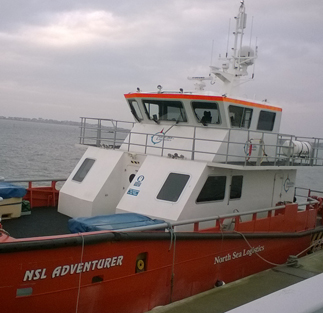Boat Electrics & Electronics Ltd (BEE Ltd), provides support services to a UK off-shore energy servicing companies, North Sea Logistics (NSL).
Off-shore, windfarm-generated, energy production has seen visible growth around UK waters. Engineers require access to the turbines all year round; for the build of the windfarm turbines, which are fixed to the sea bed, and then for maintenance. To reach the turbines you most commonly use specialist, aluminum, Windfarm Service Level 1, catamaran boats. These boats have a flat bow which presses against the turbine tower wall for docking. The boats stay in position, using only the propulsion of its engines, while engineers disembark. The engineers then climb a ladder on the turbine tower wall to a platform, sitting at around 8m above sea level, and from here, they can enter the turbine through a door. Most modern turbines have a lift inside which is used to take the engineers to the generator and other active parts of the turbine to work.
A windfarm may have as many as 100 turbines, spread up to ten miles out to sea. The result is that each farm can have two or three Windfarm Service boats in continuous use. The catamarans, worth between £2 and £3m, are designated high-speed, light craft. They carry up to 12 passengers, three crew and equipment. As well as Windfarm Service Level 1 categorisation, they meet stringent, DNV-GL, maritime safety compliance standards.
BEE Ltd, which has facilities at the ports of Irvine, Kip, Argyll and Cowes, provides electronic system installation and support for the windfarm servicing catamarans and other types of boats. The electronic systems covered include radar, GPS, systems for navigation, satellite, chart computers, echo sounders, radio systems and CCTV surveillance. The latter is used for both security and health and safety purposes.
Matt Davy of BEE Ltd said: “IP surveillance cameras monitor the engine room, which is a class requirement for boats with un-manned engine rooms. They also monitor fore and aft decks, port, starboard and saloon passenger areas, totaling ten cameras in all. The prime purpose of the CCTV system is to ensure health and safety, as well as give the captain visibility of all parts of the boat from the bridge, in real time. It also provides security for when the boat is docked in port.”
An eneo PNR-5316 network recorder, with 6 TB hard drive and iRAS management software, provides live camera viewing on the catamaran’s display systems, meaning no extra, specific monitors are needed. The PNR records each camera’s 2MP video stream in Full HD, real-time, for over 31 days. Playback of recorded images is provided on the same displays.
Matt Davy added: “The catamarans are built with Panasonic cameras fitted, so the eneo recorder had to integrate with these using the ONVIF universal protocol. This integration was seamless and has proven to be extremely reliable and effective. The recorder was easy to install on each ship’s bridge, thanks to the integrated PoE switches and the DHCP server. Apart from technical reliability, compact size is paramount when installing a CCTV system aboard boats, due to limited space. At only 62 x 300 x 232 mm, it is amongst the smallest available, so the ideal choice for marine applications like this.
“BEE Ltd is very pleased with the performance, reliability and efficient integration from the eneo PNR recorders. We will be using them again in similar applications.”
Visit www.eneo-security.com.










